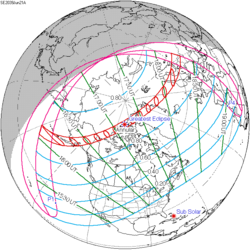| Total eclipse | |
| Gamma | −0.9333 |
|---|---|
| Magnitude | 1.0342 |
| Maximum eclipse | |
| Duration | 111 s (1 min 51 s) |
| Coordinates | 84°48′S10°36′W / 84.8°S 10.6°W |
| Max. width of band | 329 km (204 mi) |
| Times (UTC) | |
| Greatest eclipse | 18:59:03 |
| References | |
| Saros | 152 (17 of 70) |
| Catalog # (SE5000) | 9718 |
A total solar eclipse will occur at the Moon's descending node of orbit on Saturday, January 16, 2094, [1] with a magnitude of 1.0342. A solar eclipse occurs when the Moon passes between Earth and the Sun, thereby totally or partly obscuring the image of the Sun for a viewer on Earth. A total solar eclipse occurs when the Moon's apparent diameter is larger than the Sun's, blocking all direct sunlight, turning day into darkness. Totality occurs in a narrow path across Earth's surface, with the partial solar eclipse visible over a surrounding region thousands of kilometres wide. Occurring about 10.5 hours before perigee (on January 17, 2094, at 05:40 UTC), the Moon's apparent diameter will be larger. [2]
Contents
- Eclipse details
- Eclipse season
- Related eclipses
- Eclipses in 2094
- Metonic
- Tzolkinex
- Half-Saros
- Tritos
- Solar Saros 152
- Inex
- Triad
- Solar eclipses of 2091–2094
- Saros 152
- Metonic series
- Tritos series
- Inex series
- Notes
- References
This will be the first of four solar eclipses in 2094, with the others occurring on June 13, July 12, and December 7.
The path of totality will be visible from parts of Antarctica. A partial solar eclipse will also be visible for parts of New Zealand, Antarctica, and southern South America. This total eclipse is notable in that the path of totality passes over the South Pole.





































































































